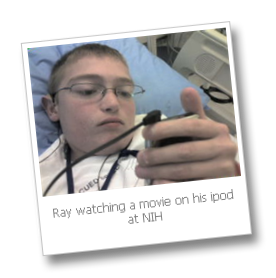Starting early Thursday morning and ending Sunday night Ray and I were staying inpatient at NIH. According to recent research, XSCID boys who do not fully reconstitute a strong immune system also have problems with growth. A number of them are below the 3rd percentile for height. It seems that even if given growth hormone, these boys do not grow. Apparently, there is a problem converting growth hormone in the liver to the next step in the process, which is the production of IGF-1. A relatively new protocol at NIH is studying the effects of giving IGF-1 to those XSCID boys who are below the 3rd percentile in height. Being short might not seem like such an important thing to some people, but to a kid who’s entering high school but looks like a 5th grader, it’s pretty important. Ray was interested in the protocol and we were too. It means a lot of sub-q injections, so he had to want to do this. We started out with blood draws about a week ago. Next Ray was given a medication for 2 days to stimulate his own growth hormone. After more blood was drawn he was given 2 IV meds to make him make his own growth hormone. Then he had to have 1 sub-q shot per day of a growth hormone, after which more blood was drawn and then 3 days later even more blood. The point of all that is to prove that no matter whether he makes his own growth hormone, or is given growth hormone, he doesn’t produce enough IGF-1. It was assumed that Ray would fail the test, which is what they wanted. Because he failed that test, he qualified to be in the study.
We admitted at NIH on Thursday to being the process of giving him IGF-1. Since the “I” in IGF-1 stands for insulin-like, there’s a slight risk that it can cause an insulin like effect and cause his blood sugar to drop too low. I’ve been told that so far, none of the boys in the study have had this problem, but it’s required that we test to make sure it doesn’t happen. He gets a sub-q shot twice a day of the IGF-1, then at 1/2 hour and 1 hour intervals after each shot we have to do a finger stick and a blood glucose level just like you’d do for a diabetic, only we’re looking for low blood sugar. We’ll have to watch his blood sugar for 2 more days after we go home, and then again for 2 days each time there is a dose increase of the IGF-1. Right now 2 dose increases are planned over the next couple of weeks. After that, he’ll only have to do the glucose testing if he has symptoms of low blood sugar. Another potential risk of the protocol is an increase in intercranial pressure. This is watched for by an ophthalmologist who looks in the back of his eyes for signs of papilledema and also we have to watch for any unusual headaches. The worst part of the whole thing for Ray has been the finger sticks to test the blood glucose. Luckily, we won’t have to do that all the time. He’s not even complaining about the shots themselves.
So the whole inpatient period was pretty boring really. We did have a couple of visitors. Neil and Parker stopped by, and Ray and Parker had fun playing video games. Ray really enjoyed having someone to talk to and play with. We walked over to the Children’s Inn so they could play the Wii over there.
So, now we wait to see if Ray starts to grow. He’s really hoping to get taller. We’re actually hoping that one of the possible side effects actually happens. Apparently enlarged tonsils is another possible side effect. Since Ray still has never developed tonsils, we’d actually consider that a positive side effect.

